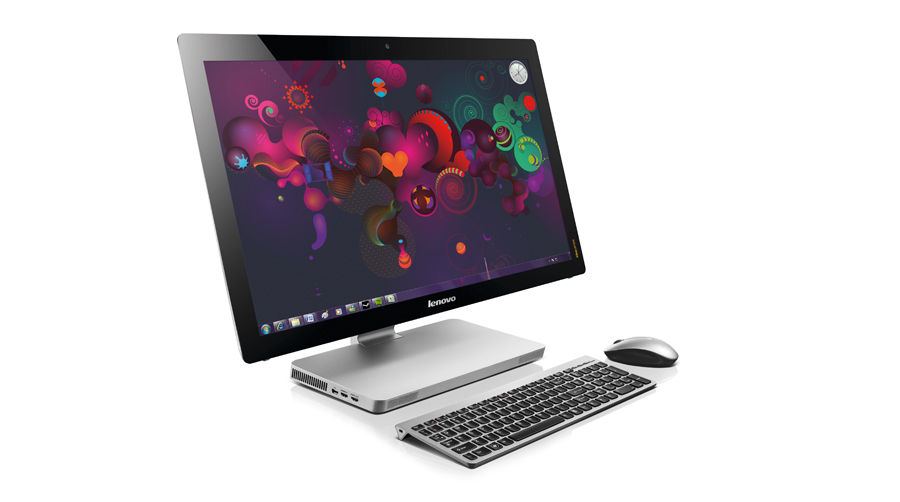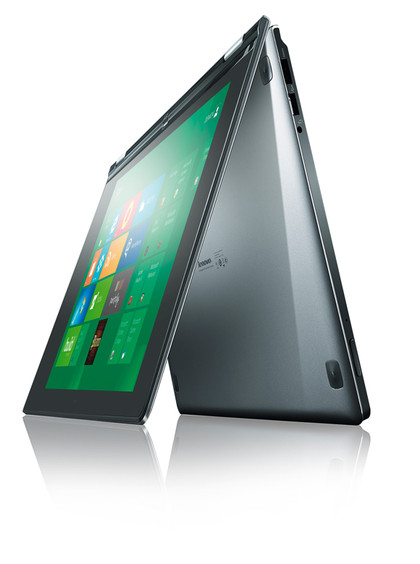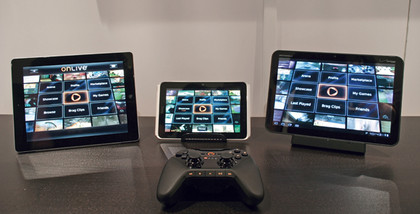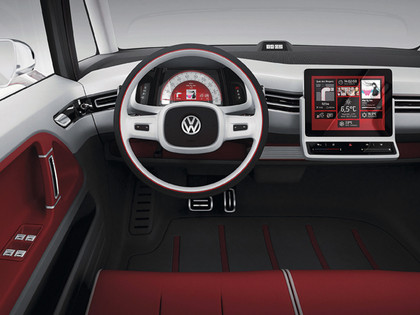
PCs have always been fairly easy things to spot: if it has a keyboard, a display, a pointing device, storage and a selection of ports, it's probably a PC.
This year, that's going to change.
Keyboards are becoming optional, and incoming technology could render them redundant. Instead of using a pointing device, you might just point, wave or blink.
Magnetic storage is being replaced by solid state storage, and more and more of your data will be stored on faraway servers. PCs are getting thinner and smarter, and evolving into ever more wonderful machines.
One thing's for sure: this year, the definition of a PC will have to become more elastic than the Incredible Hulk's purple shorts.
Ultrabooks
This year's big PC trend is the Ultrabook, which means an ultra-light, ultra-fast notebook computer that meets Intel's very exacting specifications. The Ultrabook specification comes in three parts.
The first phase demands an overall thickness of less than 21mm, a weight of no more than 1.4kg, battery life of at least five hours, a low voltage Sandy Bridge processor (a 1.6 or 1.7GHz Core i5, or a 1.7 or 1.8GHz Core i7) and Intel's HD Graphics 3000. Flash-based solid state drives are recommended but not required, and the whole thing should come in at $1,000 or less.
Get daily insight, inspiration and deals in your inbox
Sign up for breaking news, reviews, opinion, top tech deals, and more.
Phase two, which Intel has set for the first half of 2012, uses Ivy Bridge processors instead of Sandy Bridge, and adds support for USB 3.0 and PCI Express 3.0. Most Ultrabooks have 13-inch displays, but Intel is pushing manufacturers for bigger panels.
Phase two sounds impressive enough, but in 2013 the phase three Ultrabooks will get better still, as Haswell processors, the successors to Intel's Ivy Bridge, promise to offer massively improved energy efficiency for even longer battery life.
As Dave Rogers, consumer marketing manager for Intel EMEA, explains, making very thin portable PCs without compromising performance presents multiple challenges. "The first is to design chips that operate at a thermal design point - that is, they need to give off less heat. That means the cooling challenges are made easier, and this in turn means less space being taken up with cooling solutions such as fans, vents and so on."
It's not just a matter of chucking in an ultra-low voltage processor, though. "Once you have taken steps to deal with the heat, there are the physical dimensions to take care of: the bread and butter length, breadth and depth/height. The more svelte you can make the chips, the better in terms of easing the industrial design constraints."
So how do you put processors on the SlimFast plan? "The first part is taken care of by removing the pins of the CPU and using balls of solder to connect the CPU to the rest of the system," Rogers says.
"Then there is the substrate. The thinner you can make that, the better, and that's why we've put in the time - not to mention money and human resources - into achieving just that. It also helps if you can integrate as many of the components into as few bits of silicon as possible."That's why the second generation Intel Core processors' graphics are integrated into the CPU.
There's more to the Ultrabook than impressive engineering and thin components though. At this year's Consumer Electronics Show, Intel demonstrated the technologies it thinks will make Ultrabooks a big hit.
There were Ultrabooks using NFC (Near Field Communications), enabling you to pay online by tapping your credit card against your PC; and gesture control, where your Ultrabook's webcam offered gesture recognition to control on-screen elements.
Monkey business
NFC and gesture control have obvious benefits, but some of Intel's other ideas are rather less attractive. In its CES showcase, the company showed Ultrabooks with voice recognition software, which has been available on PCs in various forms since the 1980s, and it defied ergonomics by advocating touchscreens on Ultrabooks.
While such screens could be useful for quick swipes and taps, prolonged use of near-vertical touchscreens famously causes Gorilla Arm syndrome, a superb name for the feeling you get when your arm becomes uncomfortable and unwieldy because you're waving it around like a loon. It's also a recipe for irritation when you're prodding an ultra-light device: if your touch isn't light enough, your expensive Ultrabook becomes Captain Wobbly.
Ultrabooks are beautifully engineered, but we can't help thinking Intel is resurrecting some ideas that have been tried before with little success. Take voice recognition, for example.
It's back in the spotlight thanks to Apple's Siri, but what makes that system interesting is the back-end: instead of the familiar model of voice recognition, where the speech data is stored and processed locally, Siri is cloud-based.
That massively expands the amount of data the system can access, the number of users' speech data it can analyse, the processing power it can take advantage of and its ability to do its job properly - unless you're in Glasgow, that is, because at the time of writing Siri doesn't cope well with various UK regional accents, Glaswegian among them.
There's another problem with voice recognition: it needs to work first time, or it becomes infuriating. If you've ever spent an evening bellowing "Xbox!" at a Kinect sensor you'll know that even with dedicated hardware, voice control can be flaky.
That's why, despite speech recognition being built into Windows 7, most of us use keyboards and mice or trackpads.
It's a similar story with touchscreen PCs. They've been around for decades, and they've never sold in significant numbers because of the aforementioned Gorilla Arm, and because their software was designed for keyboard and mouse, not fingertips.
For example, HP has tried very hard with its TouchSmart devices, which are among the very best designed touchscreen Windows PCs you can buy, but Windows 7's touch features are an afterthought, not part of the DNA. That means that despite HP and Microsoft's best efforts, the touch control is fiddly, not fluid.
Windows 8's UI may change that slightly – its Metro interface was designed specifically for touch, and on suitable hardware like Lenovo's IdeaCentre A720, which has a hinge that turns it from desktop PC into something more like a tablet with a near-horizontal surface, it should be a joy to use.
But touch needs to be there from the beginning of the design process for hardware and software. Merely taking features from tablets and grafting them onto normal PCs is a tactic we've seen before, and it usually ends in compromised PCs that add cost and complexity to the manufacturing process without making the hardware significantly better.
Perhaps the answer isn't to try to make PCs more tablet-like. Perhaps the answer is to accept that in many cases, tablets are PCs - because that's where the industry is heading.
Here's a question: what is a PC? It stands for 'personal computer', of course, but to most people it's a very specific kind of personal computer: a desktop, laptop or all-in-one running Windows, OS X or Linux. After that, things get rather murky.
Let's take three examples. First up is the Ultrabook. Is it a PC? It looks like a PC, it's packed with familiar PC components, and it runs Windows by default. There's no argument: an Ultrabook is a PC.
Our second example is a Chromebook, a Google-powered laptop. Purists might quibble because they run ChromeOS, but in almost every respect bar the OS, a Chromebook is identical to a Windows PC. Refusing to accept it as a PC seems rather pedantic.
We think most people would let the Chromebook into a PC party, but would they let a tablet in? If not, where is the line? It can't be the keyboard, because if you sawed the keyboard off an Ultrabook you'd still have a PC. It can't be the lack of magnetic storage, because many PCs have SSDs instead of hard disks. And it can't be the processors, because the latest tablets are packing quad-cores that equal their desktop equivalents.
Is it their ability to play PC games? The Unreal engine runs beautifully on iOS, and we've seen The Elder Scrolls V: Skyrim running on Asus's Transformer Prime, albeit streaming rather than rendering in real time.
And we can't discriminate on grounds of OS, because we've already let Chromebooks into our party and they're nibbling at the canapes. With Windows 8 tablets on the horizon, if lack of Windows is the deal-breaker, it won't be for long. As Dave Rogers says, until now we've focused on the 'computer' bit of 'personal computer'. Now it's time to pay more attention to the 'personal' bit.
"'Personal' is the key driver of change," he says. "Once upon a time, the PC was a device where to use it, the user needed to adapt to it. As technology continues to advance, and the performance of devices continues to increase, it is increasingly possible to build devices that adapt themselves to the needs of the user."
Whether they're Ultrabooks, tablets or something else, PCs are evolving into some very interesting shapes.
Cool convertibles

Microsoft is taking a big gamble with Windows 8. Whereas iOS and Android are designed solely for mobile devices and don't try to offer everything a desktop OS does, Microsoft wants Windows 8 to deliver the full Windows experience across a wide range of devices.
One of the most intriguing of these is what Microsoft calls the convertible. In its list of Windows 8 tablet specifications, Microsoft says that the convertible form factor is "defined as a standalone device that combines the PC, display and rechargeable power source with a mechanically attached keyboard and pointing device in a single chassis. A convertible can be transformed into a tablet where the attached input devices are hidden or removed, leaving the display as the only input mechanism."
If Lenovo's IdeaPad Yoga 13 is any indication, convertibles could be quite special. The Yoga 13 is a modern twist - no pun intended - on Microsoft's Tablet PC from the beginning of the millennium. It's a 13-inch Ultrabook running Windows 8, but in addition to standard Ultrabook mode it also offers extra options: tent mode, an upside-down V for watching video or reading; and tablet mode, where the screen swings around and turns the device into a tablet, complete with multi-touch.
The Ultrabook form factor and Ivy Bridge processor means it isn't too heavy or power-hungry to be a successful tablet, and Windows 8 means it can offer a stripped-down tablet interface but also do the grown-up PC stuff when you need a Windows laptop. Many devices promise the best of both worlds, but the Yoga looks like it might just deliver it.
The convertible form factor also supports a modular approach, with the tablet as the main device and the keyboard and other components as optional extras. We've seen Asus and Motorola tablets with keyboard docks containing additional ports, full-sized keyboards and additional batteries for longer life, and we're likely to see Windows tablets embracing similar ideas under the Convertible banner.
By moving half the battery and most of the ports and connectors to a dock, tablets can remain sleek, light and eminently portable without sacrificing any expandability.
There's one big problem with tablet docks though, and that's their size: if you dock a 10-inch tablet, you have a 10-inch monitor. For those of us used to larger screens, docks need to be bigger and better.
Thinking big
Much like laptops, tablets are compromise devices: if your priorities are affordability, portability and superb battery life, you're not going to need a 27-inch screen, the most powerful multi-core processors and a ridiculously powerful graphics card.
That's not a problem for online shopping, word processing and arguing on Twitter, but graphics professionals, gamers and anybody else with demanding requirements will need a bigger display and a powerful GPU to drive it. Can tablets provide that?
In the short term, the answer is yes - if tablets get Thunderbolt ports and the necessary driver software. Intel's proprietary, high bandwidth interface makes it possible to connect devices to large displays and external GPUs like MSI's forthcoming GUS II.
It's an enclosure for PCI Express graphics cards, and MSI promises that it'll be powerful enough to run an AMD Radeon 5770 HD or equivalent. AMD seems to be thinking along similar lines, but using its own connector, not a Thunderbolt one.
Tablets have another trick up their sleeve: mirroring. The approaches differ - some tablets use HDMI cables, while others employ wireless technology like Apple's AirPlay, or the combination of DLNA and UPnP embraced by Sony's Tablet S, and we'd expect some Windows 8 tablets to embrace Intel's WiDi wireless-TV system when they ship later this year.
Whatever the method, the result is that you can view content on a larger device like an LCD TV. That opens up possibilities beyond mere screen sharing. The tablet could be a second screen, providing information or options that complement the larger display.
Games could use the smaller display for stats, maps or other content while the action takes place above. You could scan your media library on the smaller display without interrupting the larger one, or you could use the tablet as a control surface for your home entertainment kit.
We're already seeing apps that do just that. For example, Zeebox is designed to act as a second screen for TV, helping you chat on Twitter, find out about what's happening on screen and control compatible TVs. BSkyB has a 10 per cent stake in Zeebox and will integrate it into its various Sky apps, including Sky+ and Sky Go.
There's another way in which tablets can act as a window onto a wider world: virtualisation.
Virtual realities

We mentioned earlier that we'd seen Skyrim running on an Android tablet. It wasn't running locally; even quad-core tablets don't have the hardware heft for such a demanding game. It was running on a Windows 7 PC connected to the tablet via Splashtop's streaming software. It was played on the tablet, with commands streamed to the PC and the visuals beamed back via Wi-Fi with no discernible lag.
The PC running Skyrim was local, but if your broadband connection is good enough it needn't be - and that's where services like OnLive come in. OnLive delivers decent streaming gaming to relatively low-powered devices like netbooks and tablets, enabling them to punch way above their weight in PC gaming. It's no substitute for a tricked-out gaming PC, but for casual gaming it's fine.
Games aren't the only things you can virtualise - you can do it with Office too. OnLive's new Desktop service means tablet users don't have to wait for Microsoft to make tablet apps; they can run full-fat Microsoft Office 2010 for free.
The free service is limited - you get Word, Excel and PowerPoint, but not Outlook or OneNote, and it's on a first come, first served basis, so if the servers are busy you're out of luck. But paid-for versions offering guaranteed access are imminent, and several other firms are offering similar Office-on-your-iPad apps.
There are also remote access apps like the excellent LogMeIn, which let tablet users remotely control their PCs and Macs from anywhere with an internet connection.
By outsourcing heavy lifting to cloud-based services, virtualisation makes tablets much more useful. Devices that might struggle to run a software suite locally can let remote servers do all the hard work.
But you can outsource more than software. Increasingly we'll be outsourcing our storage too. It wasn't so long ago that when you made a telephone call, you didn't call a person - you called a building in the hope that the person you wanted to talk to might be there. We're still at that stage with our data - your music, movies, photos and files usually live locally, and if you're away from your PC, you're away from your content too.
Cloud services should do to local storage what mobile phones did to landlines by delivering truly personal computing: your stuff follows you around and is available from anywhere.
Take SkyDrive, one of the key Windows 8 features. It runs through Microsoft's OS like the word 'Blackpool' through a stick of rock, enabling you to upload data to and download data from Microsoft's massive servers. You'll be able to sync settings across multiple devices, store files, access photo albums and so on.
What that means is that your PC is whatever PC you happen to be on; no matter what the machine is or where it's situated, once you log in it's your computer.
Cloud-based storage also reduces the need for huge quantities of local storage, which is handy for ultra-thin, flash-based devices because solid state storage is relatively expensive.
Microsoft isn't the only big firm banking on the cloud: Lenovo's at it with the Lenovo Personal Cloud service, while Acer's AcerCloud and Apple's iCloud also offer cloud-based storage and synchronisation. There's also a thriving industry of third-party offerings like Dropbox, SugarSync and FilesAnywhere.
Microsoft suggests that in years to come, PC may stand for 'personal cloud', not 'personal computer'. Omar Shahine, group product manager for SkyDrive, identifies three kinds of cloud: file clouds, device clouds and app clouds.
File clouds are essentially Windows Explorer in space: they present your data using the familiar combination of files and folders, letting you access and share your content from anywhere. Dropbox, Windows Live Mesh and SkyDrive fall into this first category.
The second category, device clouds, effectively hide the folders from you. "These clouds work behind the scenes so people can easily buy and use multiple devices (phones, PCs, TVs and slates) - working or playing across them without thinking about where content is stored," Shahine says. "Today, device clouds are often proprietary to a brand or OS. The best known example is iCloud."
Then there are app clouds. Google Docs is an example of an app cloud, as is notes and clippings service Evernote. App clouds also encompass media services like Netflix, Pandora and Spotify. Cloud services lend themselves well to media delivery, whether that media is small ebooks or enormous HD videos.
Netflix and LoveFilm streams movies and TV programmes, Apple's iTunes Match streams music, and Amazon's Kindle ebooks flit from phone to tablet to PC whenever you fancy something to read. They're clever services and work really well - if your connection's up to the job.
If we're going to be trusting everything to the cloud, we'll need better connections not just indoors, but outdoors too.
Cables and wireless
If you're connected to wired broadband, things are looking up: BT Infinity's roll-out of fibre-optic broadband is ahead of schedule, Virgin Media has announced that its 50Mb customers will be upgraded to 120Mb broadband this year, and while things aren't perfect - some rural areas still struggle with sub-2Mbps speeds, and even some faster services are subject to traffic management during peak periods - the average UK broadband speed is creeping up.
Broadband.co.uk reported in December that its users had an average speed of 7.58Mbps. The weak link in many homes is wireless. While 802.11n Wi-Fi is technically capable of speeds up to 300Mbps, real-world speeds are considerably lower - and the more devices you have on the network, the more the speed suffers.
That's not an issue if you're hooking an 802.11n router up to an 8Mbps broadband connection, but when you're measuring speeds in tens or even hundreds of megabits, you might not get the maximum speed.
802.11ac, aka 5G Wi-Fi, is set to change that by delivering gigabit speeds over wireless networks. As with other wireless technologies, 802.11ac will be somewhat slower than advertised, but at this year's CES Buffalo demonstrated a router achieving actual throughput of 800Mbps.
Things are less exciting when you venture outdoors. While much of the rest of the world has 4G Long Term Evolution (LTE) mobile broadband, the best the UK can offer is 21Mpbs 3G HSPA+. Once again that's a theoretical maximum, and in practice 3G users average speeds of around 1.5Mbps.
4G promises to take speeds into double figures, with average speeds of around 15Mbps, but it'll be a while before that happens. Bickering between mobile operators in October forced Ofcom to delay the UK's 4G spectrum auction by six months, and while the regulator is adamant that the auction will definitely take place this year, that means it'll be 2014 or 2015 before significant numbers of us have access to 4G mobile phone networks.
Maybe that's a blessing in disguise; 4G LTE is a notorious battery hog, so perhaps we'll have better batteries and more efficient devices by the time we get it.
Driving forward

PCs and cars don't usually go together. High-tech cars tend to use embedded systems like Windows Embedded Automotive, which powers services like Ford SYNC, Kia UVO and Fiat Blue&Me, rather than fully-fledged PCs, but that may change as our cars become more connected.
Intel's already working on it: "Take for example, the scenario that you have a smartphone with calendar information in it and that you have an appointment somewhere outside of your normal routine," Dave Rogers says.
"Perhaps you would want that smartphone to send that information to your car's sat-nav, which would then search the best route based on time of day, roadworks and so on, and have it ready for when you left. This is an example of what Intel calls a Compute Continuum, where devices - all of which have compute capability - can interact with each other in a seamless, secure, and unobtrusive manner."
We've already seen smartphone apps supplant standalone hardware for many uses. Smartphone navigation apps can be as good as (and in some cases better than) dedicated devices, and in-car wireless hotspots could help bring car and computer closer together.
BMW's ConnectedDrive and Audi's Audi Connect both provide in-car Wi-Fi hotspots for your devices, although at present that's to keep your passengers amused rather than replace in-car entertainment systems or sat-nav.
Volkswagen has bigger ideas: its Bulli concept minivan used an iPad to control almost everything bar the driving. The docked iPad controlled the heating and air conditioning, the navigation system, hands-free calling and even the hazard lights.
Like most concept cars, the Bulli was designed to get people talking rather than show the immediate future of in-car electronics, but tablets are coming to cars near you. In December, Renault announced that it would incorporate 7-inch touch screen tablet PCs in some of its 2012 Zeo and Clios in France, and possibly in other markets too.
The tablets, dubbed R-Link, aren't removable - Renault doesn't want to provide anything too nickable - but they control the stereo, take care of sat-nav duties and tell you how green your driving is (or isn't).
Volkswagen's forthcoming Up! city car has a tablet mounted on the dashboard called Maps+More, which you can take with you to find your way around on foot.
The problem with such devices is that they're proprietary. If car firms had taken the same approach with in-car MP3 players, we'd have a mass of branded, obsolete devices in every vehicle. If tablets and cars have a long term future together, tech and car firms will have to agree on a standard to support.